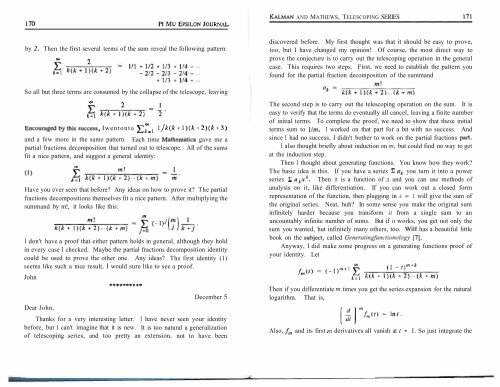Vol. 10 No 3 - Pi Mu Epsilon
Vol. 10 No 3 - Pi Mu Epsilon
Vol. 10 No 3 - Pi Mu Epsilon
- No tags were found...
Create successful ePaper yourself
Turn your PDF publications into a flip-book with our unique Google optimized e-Paper software.
KALMAN AND MATHEWS. TELESCOPING SERIESby 2. Then the first several terms of the sum reveal the following pattern:m -discovered before. My first thought was that it should be easy to prove,too, but I have changed my opinion! Of course, the most direct way toprove the conjecture is to carry out the telescoping operation in the generalcase. This requires two steps. First, we need to establish the pattern youfound for the partial fraction decomposition of the summandSo all but three terms are consumed by the collapse of the telescope, leavingEncouragedbythissuccess, Iwentonto0000l/k(k+l)(k+2)(k+3)and a few more in the same pattern. Each time Mathematica gave me apartial fractions decomposition that turned out to telescope. All of the sumsfit a nice pattern, and suggest a general identity:Have you ever seen that before? Any ideas on how to prove it? The partialfractions decompositions themselves fit a nice pattern. After multiplying thesummand by m!, it looks like this:I don't have a proof that either pattern holds in general, although they holdin every case I checked. Maybe the partial fractions decomposition identitycould be used to prove the other one. Any ideas? The first identity (1)seems like such a nice result, I would sure like to see a proof.JohnDear John,December 5Thanks for a very interesting letter. I have never seen your identitybefore, but 1 can't imagine that it is new. It is too natural a generalizationof telescoping series, and too pretty an extension, not to have beenThe second step is to carry out the telescoping operation on the sum. It iseasy to verify that the terms do eventually all cancel, leaving a finite numberof initial terms. To complete the proof, we need to show that these initialterms sum to Ilm. I worked on that part for a bit with no success. Andsince I had no success, I didn't bother to work on the partial fractions part.I also thought briefly about induction on m, but could find no way to getat the induction step.Then I thought about generating functions. You know how they work?The basic idea is this. If you have a series  ak you turn it into a powerseries E a k x k . Then it is a function of .v and you can use methods ofanalysis on it, like differentiation. If you can work out a closed formrepresentation of the function, then plugging in x = 1 will give the sum ofthe original series. Neat, huh? In some sense you make the original suminfinitely harder because you transform it from a single sum to anuncountably infinite number of sums. But if it works, you get not only thesum you wanted, hut infinitely many others, too. Wilt has a beautiful littlebook on the sub-ject, called Gi'neratinffunctionology 171.Anyway, I did make some progress on a generating functions proof ofyour identity. LetThen if you differentiate m times you get the series expansion for the naturallogarithm. That is,Also, / and its first m derivatives all vanish at t = I. So just integrate the
















